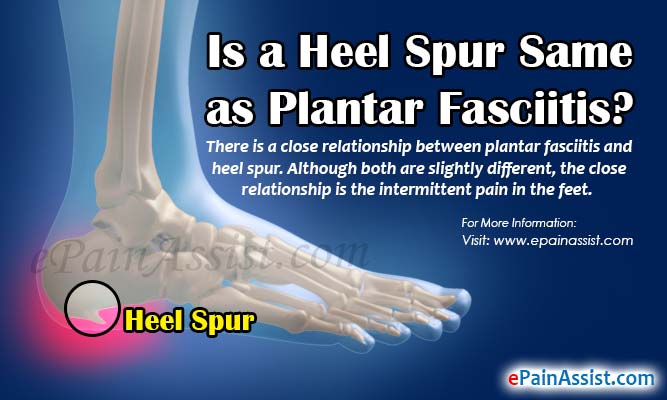Is a Heel Spur Same as Plantar Fasciitis?
There is a close relationship between plantar fasciitis and heel spur. Although both are slightly different, the close relationship is the intermittent pain in the feet. A better way to attend to the pain is by understanding the difference. It will further help in determining the cause that is leading to the development of the pain. From this, it will be easy to prepare for the treatment and reduce the symptoms and discomfort.

Difference Between Heel Spur and Plantar Fasciitis
The significant difference between the both is the source or the origin of the pain. The development of pain in the arch of the foot causes plantar fasciitis. If a person neglects the pain or overuses the feet even during the pain, it leads to the damage of plantar fascia. The development of calcium deposits on the heel bone results in heel spur, which is a response created by the body to attend to the trauma of plantar fascia.
Differences Between Heel Spur and Plantar Fasciitis Based on Causes
A better way of understanding what causes both plantar fasciitis and heel spur is imagining one-two punch. The stress and damage to the plantar fascia ligament cause plantar fasciitis. It is the region between the heel on the underside and the ball of the foot. An individual experiences extreme pain when he or she is carrying extra weight, wearing unsupportive footwear, and spending excessive time on feet.
The heel spur is the secondary development to plantar fasciitis. As there is damage to the plantar fascia ligament, the body tends to heal with the help of calcium deposits on the heel bone. Although tentative, in many cases the calcium deposits failed to offer the needed support the damaged fascia. Unfortunately, not attending to the situation will lead to further damage and erodes the fatty substance that is supporting the heel. It is permanent damage to the foot, and no treatment can solve the issue.
Differences Between Heel Spur and Plantar Fasciitis Based on Symptoms
The simplest way one can describe the occurrence of heels for is the stabbing sensation. Interestingly, it is what it exactly does because of the calcium deposits. These deposits stab into the fatty pad of the heel. An individual will experience extreme pain the first thing in the morning. Additionally, one can feel it throughout the day as it comes and goes according to the activity carried out.
For plantar fasciitis, the symptoms are more in comparison to the heel spur. Interestingly, many of the symptoms are present for some time before one experiences the same because strained or damaged plantar fascia is a primary cause for the occurrence of the heel spur. Symptoms include swelling, inflammation, and redness. It is possible for any individual to experience severe pain in the morning. However, it gets better as the day passes because of the stretch out carried out by the individual in the form of walking, standing, and other activities related to the foot.
Differences Between Heel Spur and Plantar Fasciitis Based on Treatment
Attending to plantar fasciitis is of immense importance because it can lead to the development of heel spurs. Giving the rest breaks during the day, cutting down on standing on the feet, and opting for exercise routine will be of immense help. Icing the feet is also good to reduce inflammation. At the same instance, it is necessary to choose shoes that have thick cushioned sole to elevate plantar fasciitis and heel spots. Once an individual is attending to plantar fasciitis, it is possible to cure heel spur.
Both heel spur and plantar fasciitis can be intimidating and worse. However, with a consistent track of prevention, and use of proven remedies, getting out of the situation is possible.
- Mayo Clinic. “Plantar Fasciitis.” https://www.mayoclinic.org/diseases-conditions/plantar-fasciitis/symptoms-causes/syc-20354846
- American Academy of Orthopaedic Surgeons. “Plantar Fasciitis and Bone Spurs.” https://orthoinfo.aaos.org/en/diseases–conditions/plantar-fasciitis-and-bone-spurs
Also Read:
